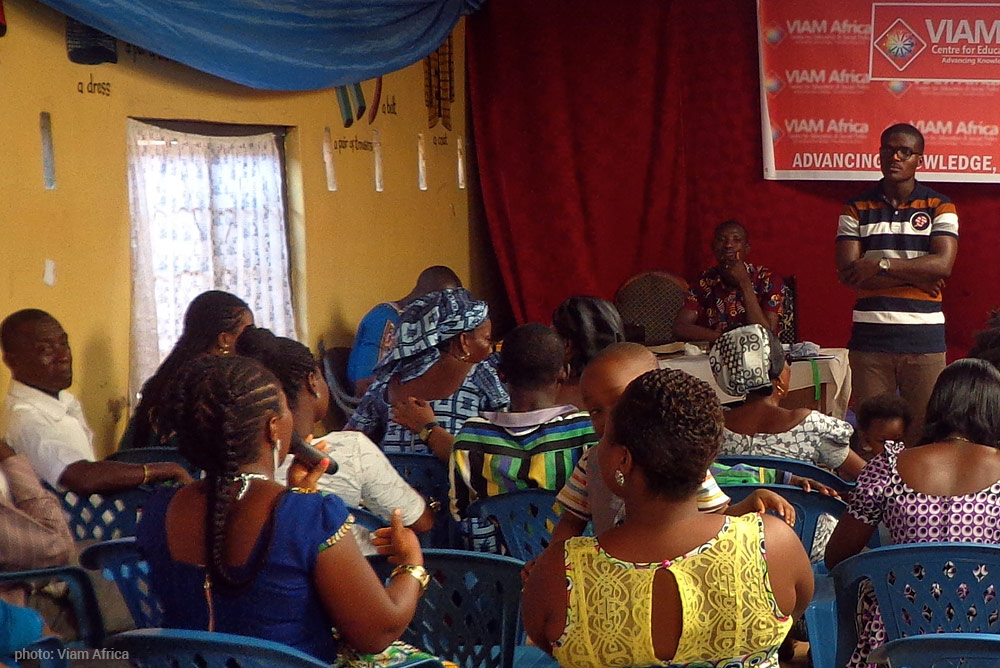Consultation Findings: VIAM Africa
In 2015, the United Nations officially recognized and commended Ghana for meeting the Millennium Development Goal of universal primary education and gender parity in primary schools. Two major policy interventions first launched during the 2004/05 academic year—the Capitation Grant Scheme (CGS) and the National School Feeding Programme (NSFP)—likely made a significant contribution to Ghana’s success story in education. The CGS abolished school fees in order to reduce the financial barriers to achieving universal access to primary education. The NSFP was developed in collaboration with the Dutch government to reduce hunger and malnutrition among school children and increase school enrolment, attendance and retention, all of which have a positive correlation with improved learning outcomes.
Yet despite this remarkable achievement, there still was a significant number of school-age children not in school (approximately half a million). In response, the government implemented a complementary basic education policy to teach the out-of-school population at designated centers with the goal of having them integrated into the formal school system by grade 3 or 4.
However, there is considerable evidence that suggests children from the poorest, most rural and hardest to reach communities in Ghana are more likely to not be in school due to financial issues, and a lack of proper school facilities and quality teachers. This has raised public concerns about the lack of access to quality education for disadvantaged children. This comes at the back of considerable investment in education with the government of Ghana committing up to 20 percent of its annual budget or around 6 percent of the country’s GDP to education. The problem is that in most cases over 80 percent of the funding allocations have gone to paying salaries of staff and officials— including ‘ghost workers’ (teachers and officials who do not work but still collect wages)— as well as inefficient public financial management practices. As a consequence, very little funding has been left for investing in school infrastructure and instruction, especially in the most deprived communities. As a result, the cost of education is still quite expensive in Ghana; and with the poverty gap widening in the country, children from low-income backgrounds are the most negatively impacted. In addition, high youth unemployment among school graduates has many parents questioning the returns on education.
In late April, VIAM Africa Centre for Education and Social Policy— a leading progressive think tank that provides independent reviews of education and social policies in Sub-Saharan Africa—conducted several stakeholder consultations to examine these issues. The main purpose of the consultations was to support ongoing steps by the Education Commission to improve financing for education through the development of a renewed and compelling investment case and financing pathways for achieving equal educational opportunity for children and young people. VIAM collated the views of over 50 participants comprising technocrats and consumers of public education at selected communities in Accra, Ghana.
From interactions with participants, it was obvious that parents and guardians were very much interested in the education of their children. For some, it was about giving their children an opportunity they never had growing up. For others, it was about preparing their children for future demands and opportunities. Their interest was however offset by economic and socio-cultural considerations. Unemployment, poor family planning, broken homes as a result of divorce, among others were reasons why parents found it difficult to educate their children. A major constraint was the skepticism over the importance of education due to the issue of graduate unemployment in Ghana. However, this was more an expression of frustration than an outright skepticism over the value of education. Participants further highlighted poor community involvement, regressive socio-cultural norms, outdated curriculums, harsh economic conditions, and poor parental supervision, among some of the major obstacles to raising educational quality in Ghana.
They projected that, by 2030, school fees would skyrocket beyond the reach of parents especially those from low-income backgrounds. As a result, they argued confidence in public schools would plummet, private schools would outnumber public schools, technical and vocational education would gain momentum, and wholesale education financing for both the rich and the poor would cease. However, they stressed that the skepticism and negativity could be assuaged if requisite reforms and financially viable alternatives for funding public schools are developed and implemented. Participants also perceived that across board financing for education has proven expensive and ineffective over the years. Thus, government should cross-subsidize and develop a special programme for people to received quality education. This includes special grants to students from disadvantaged backgrounds or low-income households. This is critical in a country like Ghana where about 24 percent of the people or some 6.4 million are living below the poverty line and cannot afford to spend GHS3.60 (less than $1) on food a day.
Although there are many barriers to increasing school access and quality education, cost is widely acknowledged as a major impediment. Given the high cost of education in Ghana relative to family incomes, the government of Ghana will have to intervene with more effective financial support for most families in the country. But it must do so in a way that removes political abuse.
Prince Armah is an Educational Consultant and the Executive Director of VIAM Africa Centre for Education & Social Policy.

